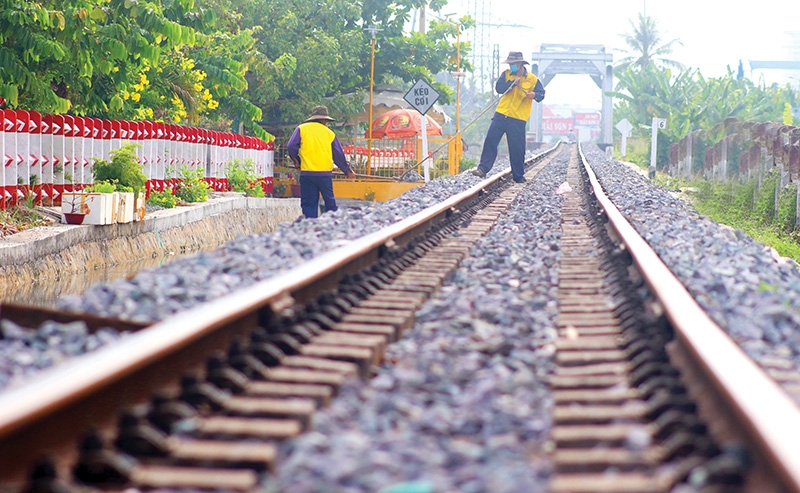Outdated framework impedes rail recovery
 |
| Synchronous infrastructure planning for specialised goods is one area requiring improvement. Photo: Le Toan |
When passenger trains of Vietnam Railways (VNR) had to cease their schedules in the first six months of 2021, VNR lost more than $17.4 million in revenues and ended with 80 per cent of the revenues in the same period in 2020 and just half of the first six months in 2019.
Vu Anh Minh, chairman of the VNR’s board, realised that the risk of capital loss was more than real, as accumulated losses in 2020 amounted to $56.5 million, while anticipated losses for 2021 currently stand at $40.9 million.
By trying to implement international routes, VNR is aiming to cut losses in the long term.
The first train with 23 40-foot containers by VNR’s Railway Transport and Trading JSC (Ratraco) departed on July 21 to Europe, opening up opportunities to transport agricultural products by rail from Vietnam to the “old continent”. Ratraco and its European partners will continue to organise eight such trips every month from Vietnam, with transit time for the entire journey estimated at 25-27 days.
Meanwhile, railways are already an optimal solution for exporting agricultural products to China, also representing a great opportunity for VNR to cut losses amid rising air and sea freight rates, as well as manual procedures and customs clearances at border gates.
Currently, the border gate between Vietnam and China in the northern province of Lang Son allows nine types of fruits to be exported to China. Nguyen Quang Tung, general director of TSY Co., Ltd., said that the Chinese side stipulates what fruit can be exported through a specific border gate.
TSY is an exporter of seafood and fruit to European and Chinese markets. For export by railway, goods go directly to Pingxiang Station in China for quarantine and import procedures. Meanwhile, transporting agricultural products by trucks takes twice as long and costs more.
Since last February, the refrigerated trains transporting dragon fruit are running directly from the Dong Dang border gate to Pingxiang, with a stable volume of goods regularly every week. Similarly, frozen fruits and other agricultural products can be exported by rail to China and from there to Central Asia and Europe.
While road transport has to deal with congestion at border gates, railways have a distinct advantage because they can clear customs very quickly as pandemic prevention and quarantine work for drivers and accompanying personnel is much simpler than on the road.
Ratraco’s cooperation with the General Department of Vietnam Customs allows the opening of more railway stations in Vinh, Dong Ha, and Dong Hoi in the central region to serve as international hubs for imports and exports via railway. It is likely that these connections will also attract fruit transports from Thailand that are transshipped by road through Laos to Vietnam, and then exported to China through the Dong Dang border gate.
Despite the advantages of international railways, the infrastructure remains the biggest weakness, limiting VNR’s cooperation plans to promote Vietnam’s agricultural exports. In 2020, VNR opened a route to transport agricultural products from the south-central province of Binh Thuan to China. However, while the amount of transported goods was high, their absolute value remained low.
The biggest difficulty for VNR is that most of its warehouses have been deteriorating, without any facility suitable to store and preserve fresh and high-value goods. The entire railway system has currently only four stations with cargo yards and equipment for handling and storing containers: Lao Cai, Dong Anh, Yen Vien, and Trang Bom.
Tran Thanh Hai, deputy director of the Foreign Trade Agency under the Ministry of Industry and Trade, spoke at many domestic and international conferences about the lack of synchronous infrastructure planning for the transportation of specialised goods such as agricultural products and, at the same time, the lack of connections between railways and river and seaports.
“Vietnam Railways has four international transport stations for agricultural products and all of them are in the northern region. Meanwhile, it is required to also have several of these stations in the central and southern regions to facilitate international trade by railways,” Hai said.
VNR built one more temporary warehouse with a capacity of 2,000 square metres at Song Than Station in the southern province of Binh Duong for standard bulk cargo handling, but Hai argued that this warehouse fails to meet the standards for the distribution of commercial goods.
VNR’s plan to stop its losses is also affected by the lack of synchronous connectivity with other modes of transport. Some important economic regions such as the Mekong River Delta and the Central Highlands do not yet have any railways.
Investment and development in the railway sector requires high synchronisation with infrastructure and facilities. The railway investment rate is high, but commercial advantages remain low compared to other types of investment, with long payback periods and an unattractive feasibility for financiers.
What the stars mean:
★ Poor ★ ★ Promising ★★★ Good ★★★★ Very good ★★★★★ Exceptional
Related Contents
Latest News
More News
- Vietnam urged to shore up supply-chain resilience amid global uncertainty (December 10, 2025 | 18:47)
- Unpacking new momentum in Vietnam’s M&A market (December 10, 2025 | 09:59)
- Forum honours outstanding M&A deals, strategies, and advisory firms (December 09, 2025 | 18:22)
- Vietnam enters defining phase of M&A growth (December 09, 2025 | 17:00)
- Landscape strong for domestic acquisitions (December 09, 2025 | 15:34)
- FDI in Vietnam jumps on additional capital and share purchases (December 09, 2025 | 13:56)
- THACO and Hyundai Rotem sign strategic railway partnership (December 09, 2025 | 12:14)
- Fundamentals required for M&A wins (December 08, 2025 | 11:08)
- When infrastructure shapes the flow of capital in logistics (December 08, 2025 | 10:39)
- Vietnam positions logistics as strategic growth engine (December 08, 2025 | 08:00)

 Tag:
Tag:






















 Mobile Version
Mobile Version